Fany Gerson made a long trip to Mexico in 2010, gathering researchfor her first book, “My Sweet Mexico”. When she returned to New York, she was determined to share and celebrate the frozen sweets of her native land. Fany decided that she would open an ice cream shop, with a strong focus on a favorite frozen treat of Mexico, the paleta. La Newyorkina was to evolve from one cart on Hester Street to several
ones, including Red Hook and Rockaway locations in Brooklyn.
They Symrise team sat down to talk with Fany and find out what inspires her sweet creations.
Symrise: Our Symrise team was very impressed when we were walking on the High Line and stopped by to taste your paletas. I understand that you were born and grew up in Mexico – what part of the country are you from?
Fany Gerson: I was born and raised in Mexico City and came to New York to attend the Culinary Institute of America. Then, I decided to stay here.
S: So what was it that led to opening up a shop selling paletas? I understand that this wasn’t always on your mind.
FG: Before I left Mexico, I knew I wanted to open a business although I didn’t know what kind of a business it would be. I was motivated by the fact that you work very hard in the food industry so I figured that if I was going to work so hard for someone else, I would rather work for myself and have the creative freedom. I felt compelled in wanting to share the sweetness of my country but frankly, I didn’t know how I could begin to make this a reality. I wanted to make candy and bread and many different things. Then one day, it came to me, a dream that I would open a Mexican ice cream store in the U.S. – that’s what it was going to be! I guess I was recalling visiting this ice cream ‘town’ in Mexico – not actually a town - but a section on the outskirts of Mexico City. It was a section that inspired the book to begin with and it made sense. I thought I would start with paletas because they are the quintessential representation of frozen treats in Mexico and nobody was doing them here in the States in the way that I was craving them or in the way I thought they could be done.
CLICK HERE to view International Street Food: Mexican Street Food
S: What flavors did you feature at first?
FG: Well, I thought of traditional flavors at first so when I was thinking of the first five flavors to do, I wondered if I should go with the flavors that I believed would sell very well – like strawberry - or should I go for something I found very interesting, like some of the Mexican flavors and that’s what I ended up doing.

S: So what were the five flavors that you settled on?
FG: Hibiscus, coconut, passion fruit, mango chili and avocado.
S: Tell us a bit about this ice cream town outside of Mexico City, what is its name?
FG: Actually, it has no name. it’s a section located near a town called San Gregorio. It’s situated in the middle of a highway, and it is known for its ice cream. It’s about five blocks long, and you can find stand after stand selling hand churned ice cream with very local flavors. They say that the ice cream is made with raw milk –whether that is accurate or not, or merely a way to promote it, the location is a very magical place.
S: You refer to paletas as being the quintessential frozen treat in Mexico – how are they made in Mexico? Is there one flavor throughout the paletas or are there layers which take you on a journey of flavors?
FG: The original form of paletas in Mexico are in a rectangular shape – some are one solid flavor and some have chunks but for the most part, it’s more like just one flavor. All strawberry, all lime, all hibiscus, and then it evolved to incorporating chili or different kinds of fruits and mixtures. So there is really not one rule. In each selling place, you will find something for every palate – smooth ones, chunky ones, filled flavors, different colors, layers of flavors and you also have water-based or milk- and creambased varieties. The majority are waterbased.
S: How are you inspired to create different flavor combinations?
FG: For me, that is the easier part because there is always inspiration all around. There’s always something that I am nostalgic about, or crazy about, or something I have not enjoyed in a while. In the summer in New York, I am also inspired by the produce that I find here. Or, if you dine somewhere, you eat something that makes you think about trying something entirely new and different. So, really, inspiration is all around you. It’s more about having the time to execute the concept – getting to do it is the challenge especially with businesses in different locations.
CLICK HERE to view Inforgraphic: Latino Snacking
S: Are you inspired by old fashioned Mexican desserts?
FG: There’s always a nostalgic factor, not necessarily from the dessert itself but usually from the flavor that is in it. Like a certain texture from a candy that is indigenous to a special region. For example, in the north of Mexico they have these delicious caramels that I really love, called ‘glorias’. They are made with goat’s milk, caramel and pecans. When I’m craving these candies, I may want to convert it into a paleta. There is also a dessert made from curds cooked in syrup – this translates better into an ice cream because of its texture. It’s always a matter of how people will receive it, whether they are looking for a traditional or a new experience.
S: What about two layer creations and the journey people take when they experience different tastes at the top and going down to the bottom?
FG: It depends on where people are from.
Customers from Europe tend to prefer single flavors, familiar flavors, they are sort of conservative. Customers from India relate to Mexican flavors that are sour and spicy. New Yorkers are always about looking for an experience – whatever is perceived as different or trendy – tastes they heard about or read about. It’s a very individual experience because we have different flavors, different textures. Personally, I like chunks but some don’t like texture at all.

S: What are the most popular flavors among youngsters?
FG: The kids by themselves are much more adventurous than when they are with their parents. They like to choose flavors based on colors – they say they want the ‘red one’ or the ‘yellow one’. We try to steer them away from spicy flavors. Very young kids love the avocado because it’s very creamy and they don’t think of it as savory. They relate it to guacamole. It’s a different story when they are with their parents, who tell them, ‘you’re not going to like it’. When kids are left to their own choosing, they love passion fruit and they are accustomed to the flavors that are like the ‘Sour Patch’ varieties.
S: Have you an example of a color ‘red’ that might appeal to kids?
FG: One year we combined beets and hibiscus. Now beets are not an easy flavor so we even hesitated but we were willing to let them try it.
S: Are you working with any flavors that go beyond Mexico to other Latino countries?
FG: I try to stay focused on the Mexican identity but my culinary training is Classic so I can put a French touch, refining Mexican tastes in that way. I made a creamy paleta with sour cream and roasted apricots, more in French than a Mexican style. I guess I am challenged by needing to rely on what we have here. Many tropical fruits from Latino countries are just not available here and vice-versa so you need to adapt to these conditions.
S: Speaking of tropical fruits, what do you think of guanabana? Do you think it will be accepted here?
FG: Oh, how I wish I could get that here. You can get the puree, without the seeds, without the pulp and that’s where the true taste comes from. I keep looking for it, and finally found some in syrup but I need to control the amount of sugar, so it’s not easy to work with. As far as its acceptance, I could see it taking off in New York because once you try it, you will love it. Its taste is between a pear and a lychee. You know, you need to break cultural barriers. Here it is difficult to find watermelon with seeds. Watermelon paletas in Mexico come with seeds but you could not sell that in America.
CLICK HERE to subscribe to the weekly in-sight newsletter!
S: What about guava – do you use it in your flavors?
FG: There was a time when you could not find guava. I combine guava with mango and cheese for a cheesecake flavor.
S: What other combinations have you created?
FG: I love Pineapple Upside-down Cake which inspired a paleta made with pineapple jam with lime and jalapeño chili. For texture I added Tres Leches cake ‘croutons’. One of the flavors I make now is a paleta with thin slices of jalapeño – it needs to be left overnight to let the jalapeño taste run through. Last year, we made a mole, which has become a signature ice cream flavor and of course, we make our own mole. It’s interesting and people want to try it, sometimes not beyond the scoop they taste, not because they don’t like but because it is too different.
S: What’s the average age of your customers?
FG: All ages. We appeal to young kids all the way through to elderly people.
S: You are very busy, I can tell. What are you up to now?
FG: I have another business where I am making doughnuts with Mexican glazes and I am in the process of writing another book about Mexican ice cream. It’s not that I am ever out of ideas; it’s just a matter of not having the time to work at all of them!
Follow Fany on Twitter: @fanygerson




